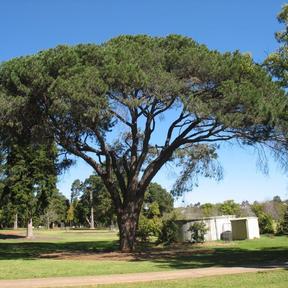Level of Significance
- File
- Local
- Regional
- State
- National
Age (approx)
100yrsTrees
1Diameter
1mHeight - 19m


Details
- Horicultural/Genetic (Scientific)
- Outstanding species (Scientific)
- Landscape (Social)
- Park/Garden/Town (Historic)
- Attractive (Aesthetic)
Statement of Significance
The rich, fertile soil, temperate climate and the interest of many of its citizens in things botanical, has resulted in Toowoomba Region’s ability to grow a wide range of indigenous and non-indigenous plants. In 1860, the area was the first to hold an Agricultural Show in Queensland – 15 years before Brisbane. Walter Hill, the then Government Botanist and first curator of the Brisbane City Botanic Gardens, travelled to Toowoomba to advise with the design and planning of Queens Park and street plantings in Toowoomba. He subsequently imported many tree species from Europe, Asia and other parts of the world to be planted there. Hill Street in Toowoomba is named in his honour. The town attracts many visitors in September for its famous Carnival of Flowers, where people come from near and far to enjoy Toowoomba’s many parks and gardens.
Queen's Park (26.3 ha), formerly a Crown Reserve and formerly known as the Botanical Gardens, was handed over to the control of the Toowoomba Council in 1865. Walter Hill assisted with its designing and planning. Many of the trees planted in Queen's Park were imported by him from throughout the world.The far sightedness and work of the early planners has provided Toowoomba with a wonderful green area close to the centre of the city. The young trees planted in 1875 now form broad avenues of mature shady trees throughout the park. Queens Park, and its superb floral presentations and leafy environment, are one of the central features of Toowoomba’s Spring Carnival of Flowers, an annual event held in September each year.
This Pinus pinea is an outstanding example of the species. It is a good specimen of an important Mediterranean cultural and food plant. The tree make a contribution to the park landscape as well as being one of the town’s historic trees. Besides being a really great looking tree, this Pinus pinea is a better than an average example of its species in its particular location. The seeds of stone or umbrella pines have been harvested as food in the Mediterranean region since pre-historic times. The tree has been, and is still, widely cultivated in Portugal, Spain, southern France, Italy, Greece and Turkey. Pine cones are collected when mature and stored until needed, when they are dried to release the woody seeds. The seeds need to be cracked to extract comestible pine nuts. Pine nuts now mainly come from other species of pines from Afghanistan to China. The tree was also culturally important to both the ancient Romans and Greeks and is a common landscape feature of the northern Mediterranean region. This particular Pinus pinea is located about 150 m south of the eastern end of Godsall Street, and about 15 m east of a small concrete water reservoir.







